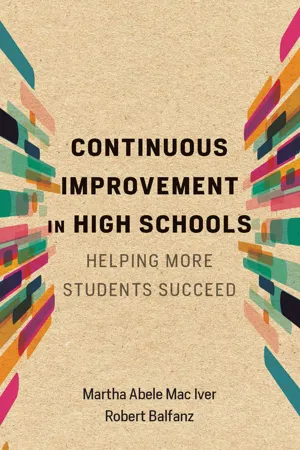
Continuous Improvement in High Schools
Helping More Students Succeed
- 192 pages
- English
- ePUB (mobile friendly)
- Available on iOS & Android
Continuous Improvement in High Schools
Helping More Students Succeed
About This Book
Continuous Improvement in High Schools gives educators and policymakers an accessible, actionable framework to address one of the nation's most important educational priorities: improving high school graduation and postsecondary preparedness rates. Martha Abele Mac Iver and Robert Balfanz, national experts in dropout prevention, apply the Carnegie Foundation's continuous improvement framework to the issue of student success in high school, starting with the critical ninth-grade year. A proven tool for organizational change, the framework provides a systematic structure for examining the root causes of problems and testing possible solutions. Mac Iver and Balfanz draw on their decades of experience working with educators and their deep knowledge of challenges faced by high schools to customize the framework to the high school context. They model the use of improvement science principles such as establishing practical measures, conducting disciplined inquiry, and accelerating learning through networked communities. With real-world examples and ideas for change, the authors show how attention to five key areas can enrich student educational experience and improve high school outcomes. These areas are early warning and intervention systems; family engagement; students' sense of connectedness to school; social, emotional, and academic development; and teacher instructional practices. The guidance offered in this useful work will enable educators and their collaborating partners to create their own powerful solutions for student success.
Frequently asked questions
Information
Table of contents
- Cover
- Title Page
- Copyright
- Dedication
- Contents
- Introduction
- Chapter 1: Identifying the Problems and Consulting the Stakeholders
- Chapter 2: Examining the Variation in High School Outcomes and Inputs
- Chapter 3: Considering the System That Produces High School Outcomes
- Chapter 4: How Can We Measure Change So We Know If Improvement Is Occurring?
- Chapter 5: How Can We Use “Disciplined Inquiry to Drive Improvement” in High School Outcomes?
- Chapter 6: Building Networks to Share Learning About Improving High School Outcomes
- Chapter 7: Confronting the Challenges and Seizing the Opportunities
- Appendix: Student Survey (Perception) Measures
- Notes
- Acknowledgments
- About the Authors
- Index